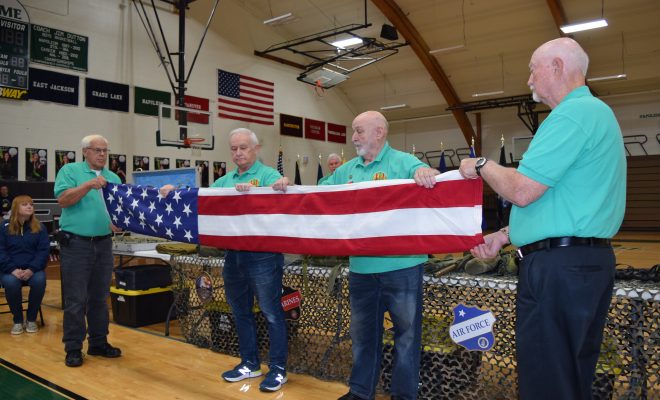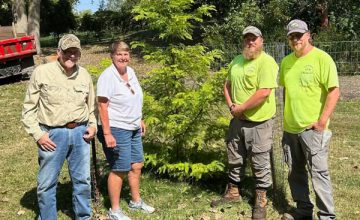Members of VVA Chapter 109 demonstrate the proper way to fold the American flag to NHS students.
Story and photos
By John Hummer
Editor
What was it like to serve in Vietnam during the turbulent times of the late 1960s and early 1970s? Students at Napoleon High School got a taste of that last Friday as representatives from Vietnam Veterans of America Chapter 109 out of Jackson came to the school to share their lives back then, recounting some of their individual moments both on and off the battlefield.
In introducing the presentation to the students, NHS principal Patrick Dillon, a U.S. Marine Corps veteran, said, “You guys probably have grandfathers, maybe great-grandfathers and great-grandmothers and grandmothers that were involved in the Vietnam conflict. We probably don’t have a great deal of history from that era, because typically, in our history classes, we don’t get a chance to get to that point. Being a former history teacher myself as well as a veteran, I think it’s a huge disservice – not only to our veterans but to our next group of adults that are going to run this country. That’s you.
Dillon continued, “My hope is that you all focus and give these gentlemen the respect that they’ve earned because they didn’t always get the respect they deserved. Whether you know it or not, back in the late sixties and early seventies – when a lot of these guys came home, when they got off the airplane, they were spat at, and they got called all kinds of vile things – and they didn’t have a choice. They served their country because they were told to.”
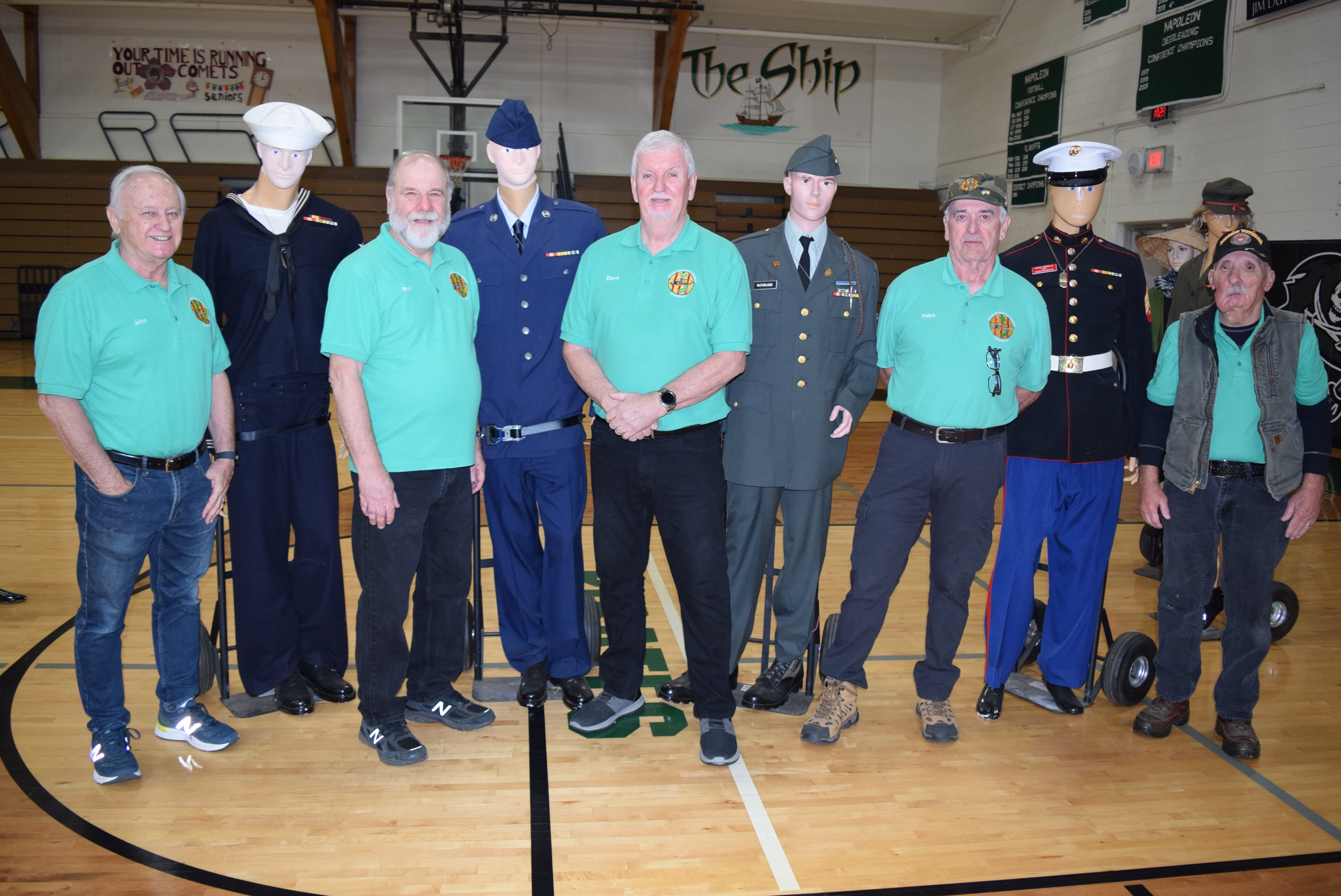
Members of VVA Chapter 109 stand next to the mannequin of their branch of service. From left U.S. Navy veteran John Grzesikowski, U.S. Air Force veterans Bob Basore and David McCave, U.S. Army veteran Ralph Yard, and U.S. Marine Corps veteran Jerry Kennedy.
The veterans discussed their jobs in the military, and the culture of the times, and had war artifacts available for students to view. There was even audience participation as a few students were called upon to assist the group during various parts of the presentation. The event ended with a segment for questions and answers in which many students participated.
It was noted during the presentation that 58,479 Americans were killed in the Vietnam War and there were 1,582 Americans unaccounted for as missing in action (MIA) or prisoners of war (POW).
Mike “Doc” Finch (whose nickname came from his work as a medic in Vietnam), president of VVA Chapter 109, explained what his group discusses during their presentation. “We talk about patriotism, we do a flag folding – we explain each fold as we go, we’ll have a volunteer and present the flag as we do for the next of kin, then we play “Taps.” (Taps is played by Vietnam veteran David McCave.) Then we go into the program where we talk about what our jobs were during Vietnam. We talk a little bit about the culture of Vietnam, and a little bit about Agent Orange,” he noted. The presentation included a slideshow of the veterans from the Vietnam war years.
The audience participation segment was a big highlight of the presentation. Maggie VanWagnen, a junior at NHS, volunteered to put on Vietnam soldier’s gear to see how heavy it was while running around the gym as her fellow students cheered her on. Another student had the opportunity to lie on a cot to see how miserable it was to sleep on.
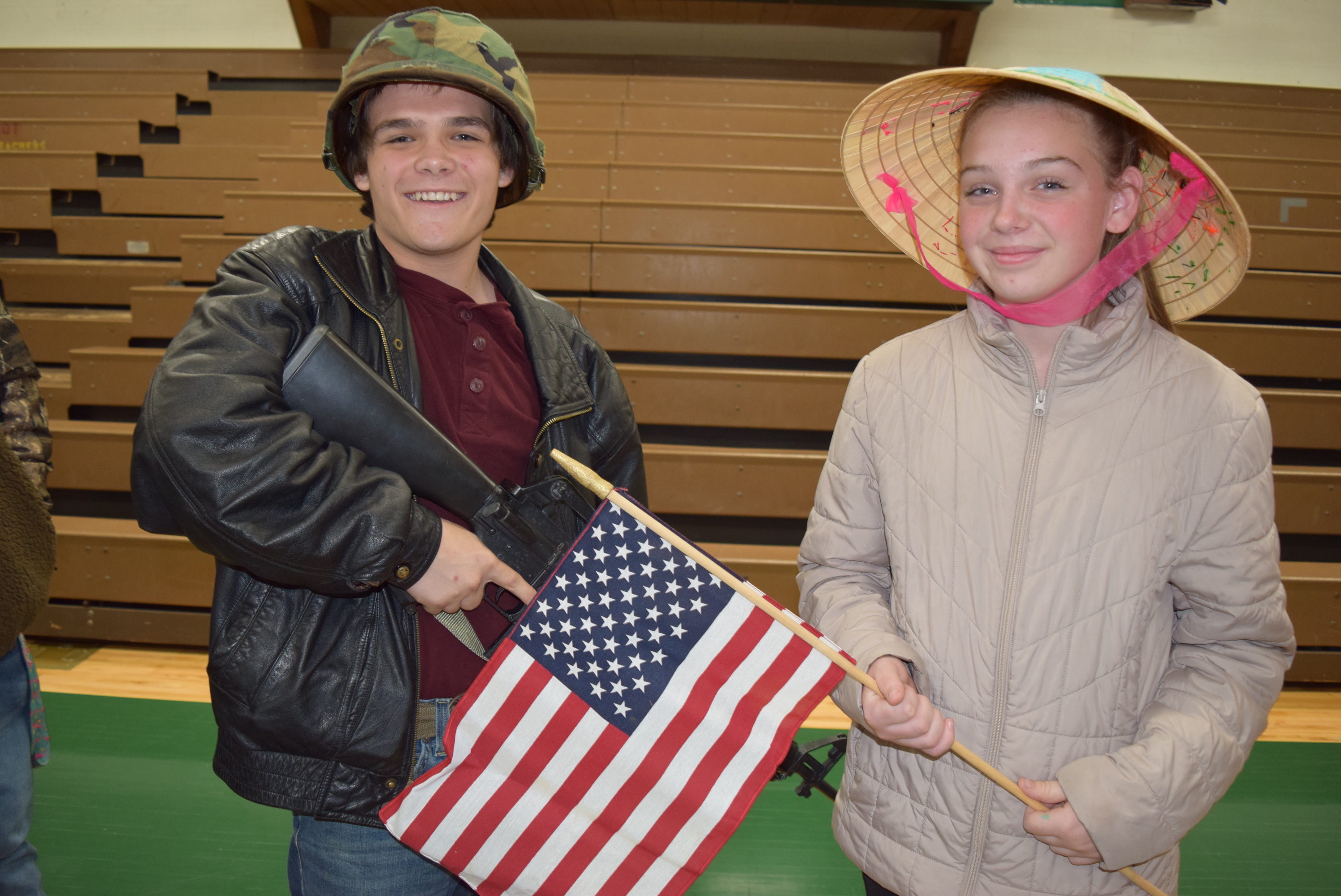
NHS sophomore John Sleight dons a helmet and wields a weapon while freshman Mattilynn Sougay looks stylin’ in headwear worn by Vietnamese people to keep them cooler in the stifling heat.
“Students get an appreciation of what the military person went through during Vietnam,” Finch said. “I know they don’t really study it much in high school because there’s so much [other] history they have to learn. A lot of them probably don’t know what Vietnam is or how we suffered, the Agent Orange problems that we have. It causes cancer, and most of us up here have had it.
“We just hope they get a little awareness of what the military goes through and actually what combat is like,” Finch continued. “We don’t get into the blood and guts of everything. We just give them an overview of what it was like to be there.”
VVA Chapter 109 has gathered a full inventory of artifacts to bring along on presentations, including equipment, pictures, letters to and from home, maps, and weapons. The team brings a world map as well as the VVA Map of Wartime Vietnam that shows locations where military units were based.
At the end of the presentation, NHS students and teachers interacted with the team members, with a chance to handle some of the equipment and memorabilia and ask questions.
John Gibbs served in the U.S. Navy in Vietnam from 1969-70. He gave a geographical description of Vietnam and what it was like for people to live on dirt streets in grassy hut homes. Their basic schools were sometimes not in session because of the war.
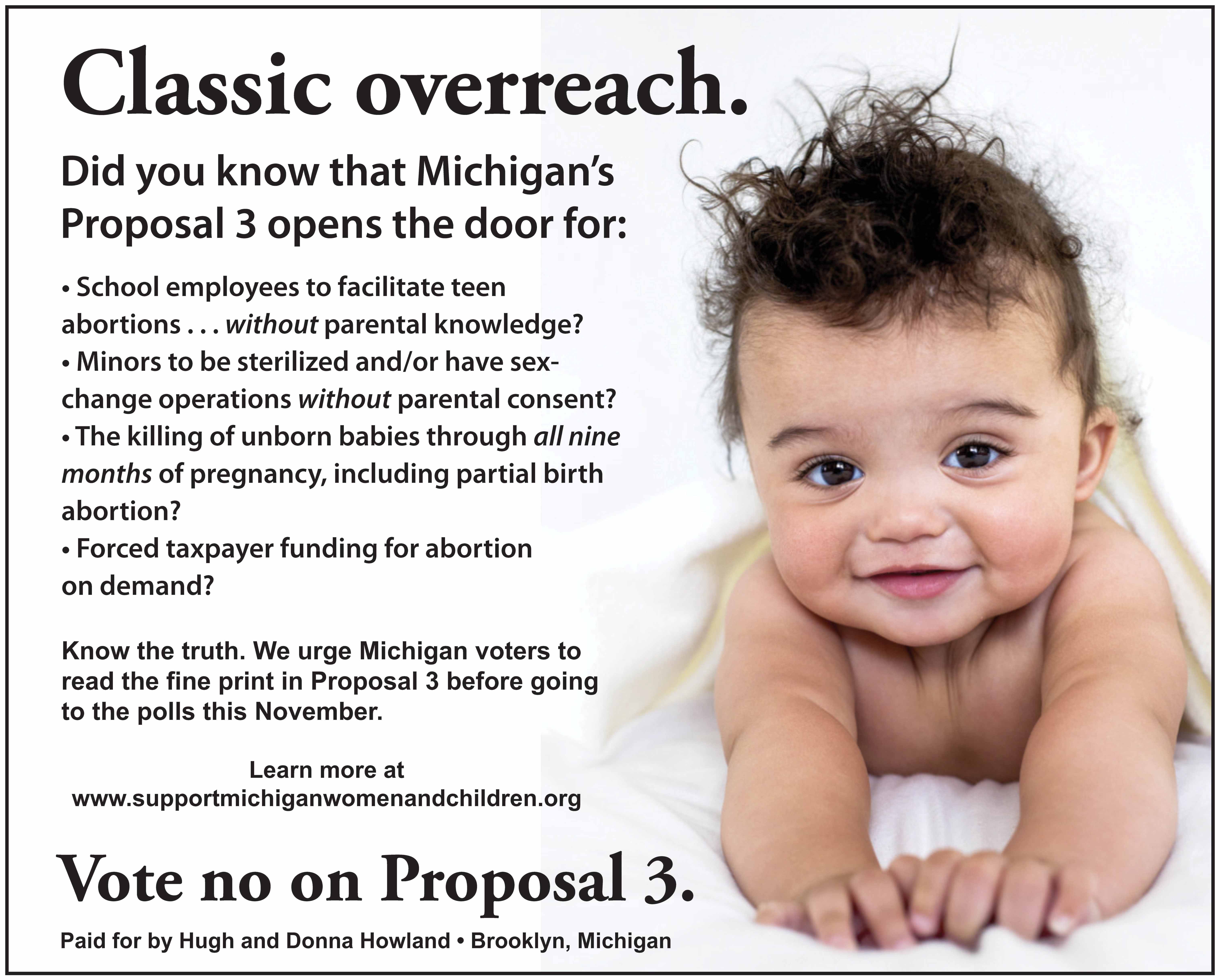
Gibbs provided some history on the purported reasons for the war – the North Vietnamese trying to impose a communist dictatorship on the South Vietnamese people who wished to remain a democracy-type nation. “They called for the United States to help South Vietnam maintain their democracy – and that’s why we were there,” he explained. “We were fighting against the North Vietnamese soldiers and the Viet Cong.”
Ray Prieur, co-commander of the chapter’s honor guard, was the emcee and main speaker of the presentation. Prieur served in Vietnam from 1967-69 as a helicopter mechanic. The main part of his presentation focused on the trials and tribulations of keeping helicopters running over the battlefield in what has been dubbed the “helicopter war.” “We worked 24/7 in 12-hour shifts,” he explained, noting it was hard to get adequate rest. “You try to sleep in 95-degree weather with 95 percent humidity – it was hard.”
He also spoke about and showed some of the many different types of weapons used during the war, including a grenade launcher, the “square bomb” and land mines. Prieur also noted the deadly rockets the Vietnamese enemy used that contained shrapnel – small pieces of sharp metal that flew everywhere upon impact.
Prieur also touched upon the importance of having special footwear to fight off the diseases that could be contracted in rice fields of Vietnam and the sharply pointed bungee sticks planted by the Viet Cong that were meant to spike the enemy’s feet.
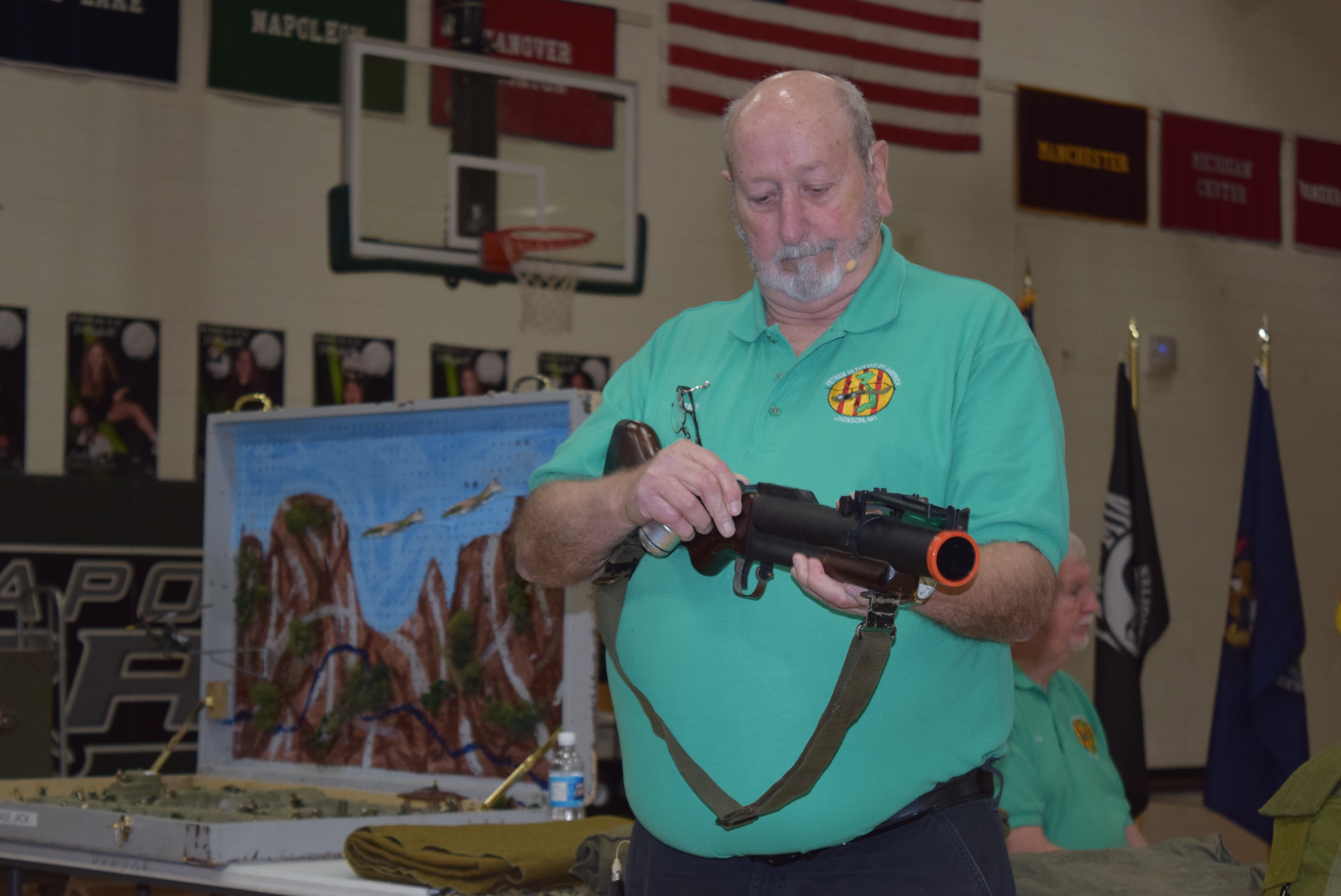
Ray Prieur, co-commander of VVA Chapter 109, displays one of the weapons used on the battlefield in Vietnam.
As if the war conditions weren’t bad enough, Prieur also reviewed the mostly undesirable food military personnel ate – mostly canned goods, including Phu quoc, or fish sauce, “that smells like dead animals” said a student who took a whiff of it. On the brighter side, he noted how meaningful and encouraging it was for those serving in Vietnam to receive mail from loved ones back home.
In his portion of the presentation, Finch spoke of many of the women in the military who served as nurses, otherwise known as “angels of the battlefield” by military personnel. He said he learned most of his medical skills from them. ‘Most of them worked six days a week, 12-hour shifts,” he said. “On their days off, they would go back to the hospital and sit with the wounded, sometimes dying soldiers, so they had some contact with people from home.” He noted that 98 percent of those hurt in battle survived their wounds in no small part due to the skills and caring of the “angels in the battlefield”. Eight nurses died in Vietnam.
He finished his presentation with some words about the devastating effects of Agent Orange. The chemical, which was said to be safe back then, was sprayed by the U.S. military in South Vietnam, where most of the fighting took place, to kill vegetation so that Americans in the combat field could see any enemies advancing.
However, Agent Orange got all over everything and everybody on the ground, including barrels of rainwater that were used by military personnel to bathe in. Post-war, it was found that the dioxins in the chemical makeup of Agent Orange are cancer-causing substances. Agent Orange has also been linked to diabetes, neuropathy, and heart problems.
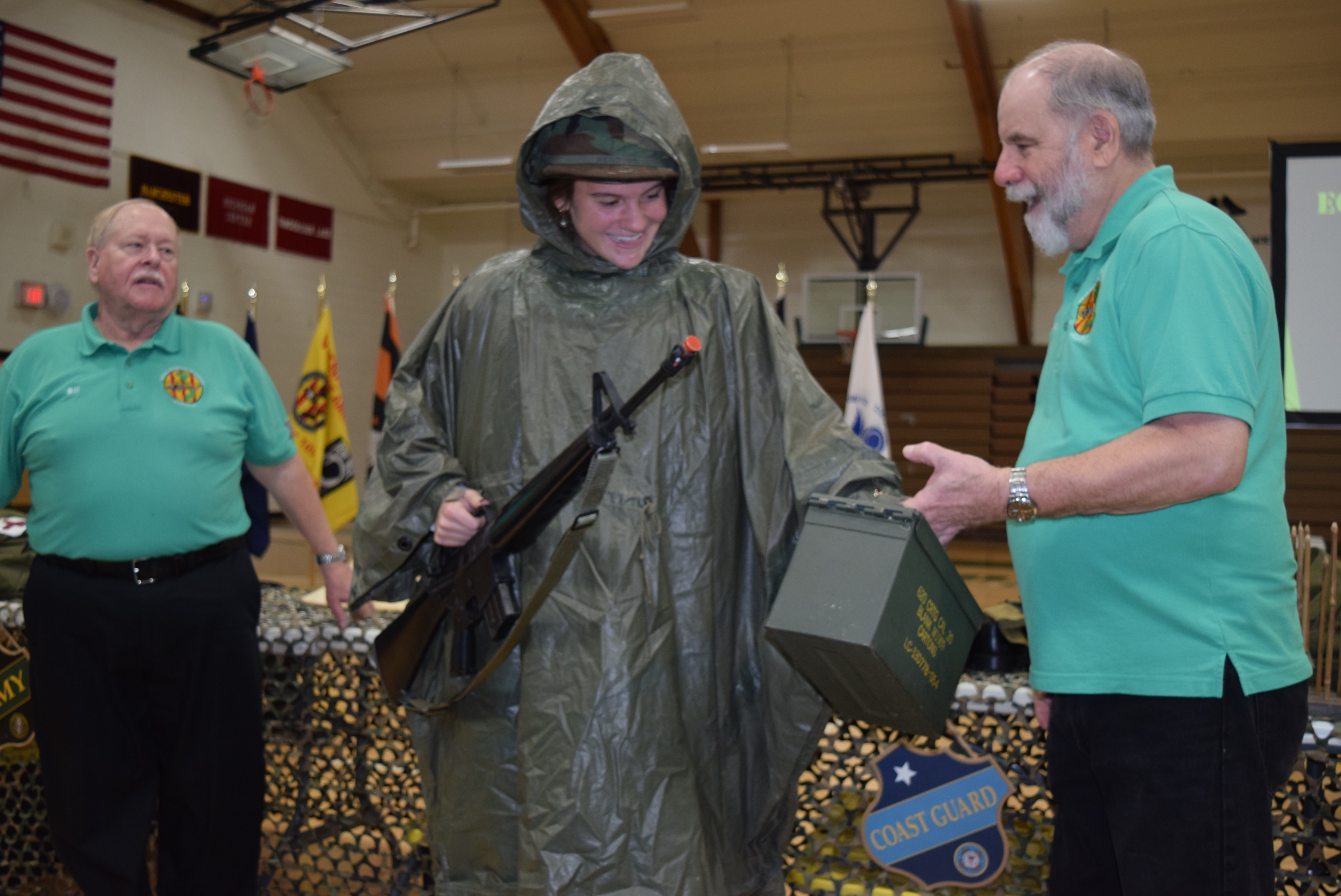
NHS junior Maggie VanWagnen has fun while wearing the full suite of combat gear soldiers wore in Vietnam, as well as carrying a guy and a box of supplies.
A few members of VVA Chapter 109 have died due to causes related to Agent Orange, including past president Robert Wilkinson, the brainchild behind the school presentations.
Other speakers included McCave who spoke about the uncomfortable cots that soldiers had to sleep in (which included a live demonstration with an NHS student).
John Grzesikowski served in the Navy with training in electronics. He worked on missiles while on the U.S.S. Albany, a guided missile cruiser ship.
Ralph Yard was a military policeman in the U.S. Army who was stationed in Alaska. He spoke of the role of war dogs in the military police.
Bill Stokka was in the U.S. Air Force from 1971-75. He was sent to Thailand where he worked on fighter bombers.

Bob Basore was also in the Air Force from the late 1960s through the mid-1970s where he was an air traffic control radar repairman. He also worked on airport surveillance radar. He served on both domestic Air Force bases and in South Korea.
John Snyder was commissioned as a second lieutenant in the U.S. Army. He worked in Vietnam as a mapping specialist.
The VVA Chapter 109 began doing school presentations in 2013 and just surpassed the 27,000 mark of students who have seen the presentation. They also make presentations to senior citizen groups. For more information, find “Vietnam Veterans of America, Chapter 109 Jackson, MI” on Facebook.


